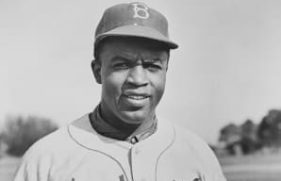
Jackie Robinson in his Brooklyn Dodgers Uniform
Postwar United States (1945 to early 1970s)
A National Archives Foundation educational resource using primary sources from the National Archives

Published By:
Historical Era:
Thinking Skill:
Bloom’s Taxonomy:
Grade Level:
This activity can be used to learn and practice photograph analysis skills in the early grades, or as an introduction to Jackie Robinson’s civil rights activism. It is appropriate for students in grades 2-4. Approximate time needed is 20 minutes.
Ask students to look closely at the photograph. Guide them through the analysis questions to learn more about the photograph. (Or ask older students who can read the questions to work in pairs on their own.)
As with any primary source analysis, students will go through the following progression, as outlined in the activity:
When students answer all of the analysis questions, click on “When You’re Done” and ask the final questions:
It’s likely that students won’t be familiar with Jackie Robinson’s name or career. Provide a brief introduction based on the following information, and hold a class discussion about Robinson’s courage and character.
In 1947, Jackie Robinson broke Major League Baseball’s (MLB) “color barrier” when he started his rookie season with the Brooklyn Dodgers. He was the first Black man to play in the MLB in the 20th century. (A player named Moses Fleetwood Walker became the first Black man to play major-league baseball in 1884.)
When Robinson joined the Dodgers, all the other players in Major League Baseball were white. Because of his race, Robinson was the target of racial abuse and discrimination. But Robinson played the best baseball he could, even as fans yelled insults at him and the entire nation focused its attention on his game.
In the course of a distinguished 10-year career, Robinson led the Brooklyn Dodgers to six National League titles and one victorious World Series. In 1962 he was elected to the Baseball Hall of Fame. Beyond his many and stellar baseball feats, Jackie Robinson went on to champion the cause of civil rights when he retired from the game. He attended the March on Washington and wrote letters to presidents and government officials.
In this activity, students will analyze a photograph of Jackie Robinson. They will practice using context clues to help them figure out Robinson’s job – playing baseball – and briefly learn about the challenges he faced breaking the color barrier in Major League Baseball.
